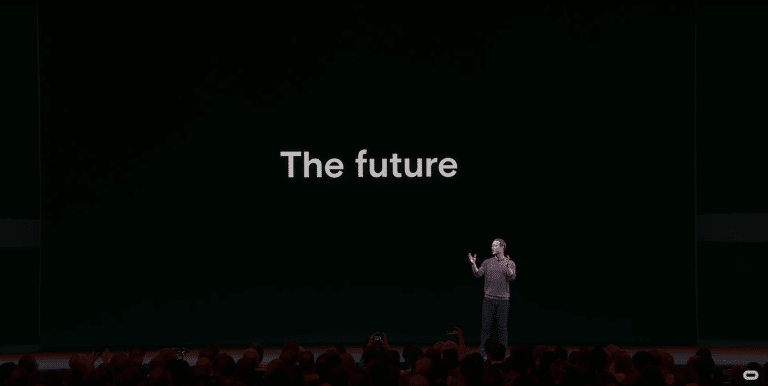
Among tech giants investing in their own versions of an AR future, Facebook arguably has the highest stakes. We’ve estimated that its annual XR R&D spend — not including its $2 billion Oculus acquisition — approaches $10 billion. It’s playing a long game and is firmly committed.
That includes both AR and VR, the latter being more tangible today, given Oculus’ in-market status. AR is earlier in its lifecycle but potentially greater in impact for Facebook and everyone else. This is partly due to AR’s potential all-day ambient use in a wearable form factor.
For both AR and VR, you could argue that Facebook is doing them a favor by investing so heavily. It’s doing so selfishly of course, but will rise other boats in the process. With Oculus for example, it subsidizes the hardware to jumpstart a network effect, which benefits consumers and developers.
To go deeper on all of the above, Mark Zuckerberg recently made a rare guest appearance on the Information’s 411 Podcast. This offered a glimpse into Facebook’s spatial computing goals and philosophies.* It’s also the topic of this week’s XR Talks, including takeaways and audio below.
Convergence
Given that Facebook pursues both AR and VR, the question is how they will play off each other. Zuckerburg sees them as two sides of the same coin, given that they share common technological underpinnings. In fact, this adjacency will cause AR and VR efforts to support each other.
In other words, the pursuit of VR helps accelerate AR and vice versa. Moreover, AR — which will mature later — will be better served if there’s already an ecosystem in place when it hits its stride. That ecosystem can be stimulated by VR, including hardware, content, and developer talent.
This will all be necessary, says Zuckerburg, because AR glasses will require a new and different tech stack that isn’t prevalent today. VR by comparison germinated earlier and had an easier path to market because it was built on the tech stack and supply chain of smartphones.
Another advantage to following both paths: economies of scale. As we examined around Apple’s potential VR headset, VR could establish the necessary supply chain for its eventual AR glasses. This involves key components like optical systems, displays, silicon and the full stack.
Network Effect
Speaking of full-stack, Facebook is notably building out the hardware, software, operating system, and even silicon. As we’ve examined, Facebook is motivated to avoid the fate it endured in the smartphone era in being beholden to the major mobile platforms: Apple and Google.
But this market positioning is a second-order motivator, says Zuckerberg. The first-order priority in the full-stack approach is performance and design. Because AR is new technology it will benefit from tightly-integrated and purpose-built components (Apple’s longstanding approach).
But when making comparisons, the more apt example is Android. Google launched the mobile OS — and made it free — so that it could steer the direction of the mobile ecosystem and place itself at the center. A similar outcome is what we believe motivates Facebook’s spatial endeavors.
Meanwhile, Zuckerberg says that Facebook could derive app store revenues as a way to fund hardware and bring prices down to boost accessibility (read: volume). This will help achieve network effect — a driver that’s deeply rooted in Facebook’s DNA. Monetization can follow.
“The thing I care most about is, can we deliver these social experiences,” said Zuckerberg. “If we can, I think what we’ve seen on the Internet is that you can build a pretty good business doing that. That’s sufficient from our perspective in terms of bringing this technology into the world.”
Evolutionary Path
Back to the technical requirements, there are still many hard computational problems to solve, which is where Facebook’s R&D investments focus. This traces back to Facebook Reality Labs’ Chief Scientist Michael Abrash’s always illuminating talks at the Facebook Connect conference.
If you’ve heard these talks, you’re familiar with the interconnected list of technical hurdles that face spatial computing. The list includes things like resolution, field of view, and efficient processing (e.g. foveated rendering). There are also key components like sound and inputs.
Zuckerberg adds to the list with the pieces needed to fulfill his vision of remote social connection, including eye contact and avatars. These are North Stars in Facebook’s spatial road map as it endeavors to make computing more human, and reduce waste from travel and commuting.
Given the depth of some of these technical challenges, Zuckerberg projects spatial computing’s fully actualized state to possibly be in the 2030’s. But until then, steps in that evolutionary path will produce meaningful spatial experiences. If Quest 2 is any indication, that’s already happening.
Listen to the full interview here or by using the audio embed below.
*This episode made a disclaimer that its intention is to focus on only Facebook’s spatial computing moves and strategies, rather than other matters surrounding Facebook such as privacy reform and content enforcement policies. We’ve done the same thing in this article.

